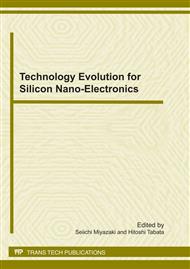p.72
p.79
p.85
p.92
p.98
p.104
p.110
p.117
p.123
Atomically Controlled Plasma Processing for Group IV Quantum Heterostructure Formation
Abstract:
By low-temperature epitaxial growth of group IV semiconductors utilizing electron-cyclotron-resonance (ECR) plasma enhanced chemical vapor deposition (CVD), atomically controlled plasma processing has been developed in order to achieve atomic-layer doping and heterostructure formation with nanometer-order thickness control as well as smooth and abrupt interfaces. In this paper, typical recent progress in plasma processing is reviewed as follows: (1) By N and B atomic-layer formation and subsequent Si epitaxial growth on Si(100) without substrate heating, heavy atomic-layer doping was demonstrated. Most of the incorporated N or B atoms can be confined in about a 2-nm-thick region of the atomic-layer doped Si film. (2) Using an 84 % relaxed Ge buffer layer formed on Si(100) by ECR plasma enhanced CVD, formation of a B-doped highly strained Si film with nanometer-order thickness was achieved and hole mobility enhancement as high as about 3 was observed in the highly strained Si film.
Info:
Periodical:
Pages:
98-103
Citation:
Online since:
February 2011
Authors:
Price:
Сopyright:
© 2011 Trans Tech Publications Ltd. All Rights Reserved
Share:
Citation:


